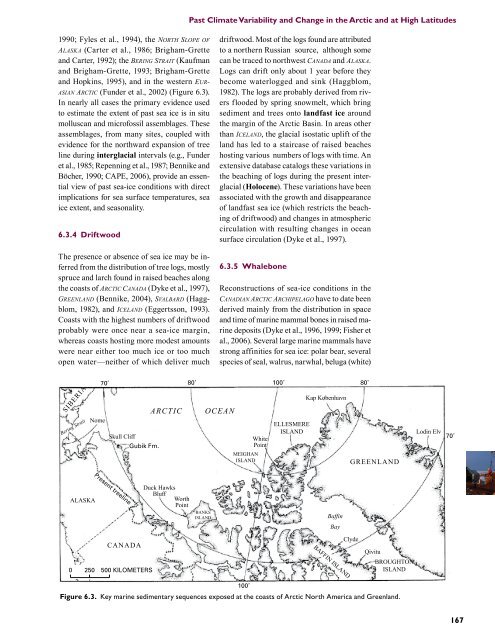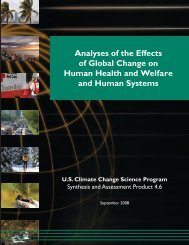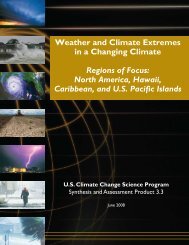Past Climate Variability and Change in the Arctic and at High Latitudes
Past Climate Variability and Change in the Arctic and at High Latitudes
Past Climate Variability and Change in the Arctic and at High Latitudes
You also want an ePaper? Increase the reach of your titles
YUMPU automatically turns print PDFs into web optimized ePapers that Google loves.
1990; Fyles et al., 1994), <strong>the</strong> north Slope oF<br />
AlASkA (Carter et al., 1986; Brigham-Grette<br />
<strong>and</strong> Carter, 1992); <strong>the</strong> ber<strong>in</strong>G StrAit (Kaufman<br />
<strong>and</strong> Brigham-Grette, 1993; Brigham-Grette<br />
<strong>and</strong> Hopk<strong>in</strong>s, 1995), <strong>and</strong> <strong>in</strong> <strong>the</strong> western eur-<br />
ASiAn <strong>Arctic</strong> (Funder et al., 2002) (Figure 6.3).<br />
In nearly all cases <strong>the</strong> primary evidence used<br />
to estim<strong>at</strong>e <strong>the</strong> extent of past sea ice is <strong>in</strong> situ<br />
molluscan <strong>and</strong> microfossil assemblages. These<br />
assemblages, from many sites, coupled with<br />
evidence for <strong>the</strong> northward expansion of tree<br />
l<strong>in</strong>e dur<strong>in</strong>g <strong>in</strong>terglacial <strong>in</strong>tervals (e.g., Funder<br />
et al., 1985; Repenn<strong>in</strong>g et al., 1987; Bennike <strong>and</strong><br />
Böcher, 1990; CAPE, 2006), provide an essential<br />
view of past sea-ice conditions with direct<br />
implic<strong>at</strong>ions for sea surface temper<strong>at</strong>ures, sea<br />
ice extent, <strong>and</strong> seasonality.<br />
6.3.4 Driftwood<br />
The presence or absence of sea ice may be <strong>in</strong>ferred<br />
from <strong>the</strong> distribution of tree logs, mostly<br />
spruce <strong>and</strong> larch found <strong>in</strong> raised beaches along<br />
<strong>the</strong> coasts of <strong>Arctic</strong> cAnAdA (Dyke et al., 1997),<br />
GreenlAnd (Bennike, 2004), SvAlbArd (Haggblom,<br />
1982), <strong>and</strong> icelAnd (Eggertsson, 1993).<br />
Coasts with <strong>the</strong> highest numbers of driftwood<br />
probably were once near a sea-ice marg<strong>in</strong>,<br />
whereas coasts host<strong>in</strong>g more modest amounts<br />
were near ei<strong>the</strong>r too much ice or too much<br />
open w<strong>at</strong>er—nei<strong>the</strong>r of which deliver much<br />
SIBERIA<br />
Ber<strong>in</strong>g Strait<br />
ALASKA<br />
70˚<br />
Nome<br />
Skull Cliff<br />
Present treel<strong>in</strong>e<br />
CANADA<br />
Gubik Fm.<br />
0 250 500 KILOMETERS<br />
<strong>Past</strong> <strong>Clim<strong>at</strong>e</strong> <strong>Variability</strong> <strong>and</strong> <strong>Change</strong> <strong>in</strong> <strong>the</strong> <strong>Arctic</strong> <strong>and</strong> <strong>at</strong> <strong>High</strong> L<strong>at</strong>itudes<br />
ARCTIC OCEAN<br />
Duck Hawks<br />
Bluff<br />
Worth<br />
Po<strong>in</strong>t<br />
BANKS<br />
ISLAND<br />
driftwood. Most of <strong>the</strong> logs found are <strong>at</strong>tributed<br />
to a nor<strong>the</strong>rn Russian source, although some<br />
can be traced to northwest cAnAdA <strong>and</strong> AlASkA.<br />
Logs can drift only about 1 year before <strong>the</strong>y<br />
become w<strong>at</strong>erlogged <strong>and</strong> s<strong>in</strong>k (Haggblom,<br />
1982). The logs are probably derived from rivers<br />
flooded by spr<strong>in</strong>g snowmelt, which br<strong>in</strong>g<br />
sediment <strong>and</strong> trees onto l<strong>and</strong>fast ice around<br />
<strong>the</strong> marg<strong>in</strong> of <strong>the</strong> <strong>Arctic</strong> Bas<strong>in</strong>. In areas o<strong>the</strong>r<br />
than icelAnd, <strong>the</strong> glacial isost<strong>at</strong>ic uplift of <strong>the</strong><br />
l<strong>and</strong> has led to a staircase of raised beaches<br />
host<strong>in</strong>g various numbers of logs with time. An<br />
extensive d<strong>at</strong>abase c<strong>at</strong>alogs <strong>the</strong>se vari<strong>at</strong>ions <strong>in</strong><br />
<strong>the</strong> beach<strong>in</strong>g of logs dur<strong>in</strong>g <strong>the</strong> present <strong>in</strong>terglacial<br />
(Holocene). These vari<strong>at</strong>ions have been<br />
associ<strong>at</strong>ed with <strong>the</strong> growth <strong>and</strong> disappearance<br />
of l<strong>and</strong>fast sea ice (which restricts <strong>the</strong> beach<strong>in</strong>g<br />
of driftwood) <strong>and</strong> changes <strong>in</strong> <strong>at</strong>mospheric<br />
circul<strong>at</strong>ion with result<strong>in</strong>g changes <strong>in</strong> ocean<br />
surface circul<strong>at</strong>ion (Dyke et al., 1997).<br />
6.3.5 Whalebone<br />
Reconstructions of sea-ice conditions <strong>in</strong> <strong>the</strong><br />
cAnAdiAn <strong>Arctic</strong> ArchipelAGo have to d<strong>at</strong>e been<br />
derived ma<strong>in</strong>ly from <strong>the</strong> distribution <strong>in</strong> space<br />
<strong>and</strong> time of mar<strong>in</strong>e mammal bones <strong>in</strong> raised mar<strong>in</strong>e<br />
deposits (Dyke et al., 1996, 1999; Fisher et<br />
al., 2006). Several large mar<strong>in</strong>e mammals have<br />
strong aff<strong>in</strong>ities for sea ice: polar bear, several<br />
species of seal, walrus, narwhal, beluga (white)<br />
80˚ 100˚<br />
MEIGHAN<br />
ISLAND<br />
100˚<br />
White<br />
Po<strong>in</strong>t<br />
ELLESMERE<br />
ISLAND<br />
Kap Kobenhavn<br />
/<br />
Baff<strong>in</strong><br />
Bay<br />
BAFFIN ISLAND<br />
GREENLAND<br />
Clyde<br />
80˚<br />
Qivitu<br />
BROUGHTON<br />
ISLAND<br />
Figure 6.3. Key mar<strong>in</strong>e sedimentary sequences exposed <strong>at</strong> <strong>the</strong> coasts of <strong>Arctic</strong> North America <strong>and</strong> Greenl<strong>and</strong>.<br />
Lod<strong>in</strong> Elv<br />
70˚<br />
167




